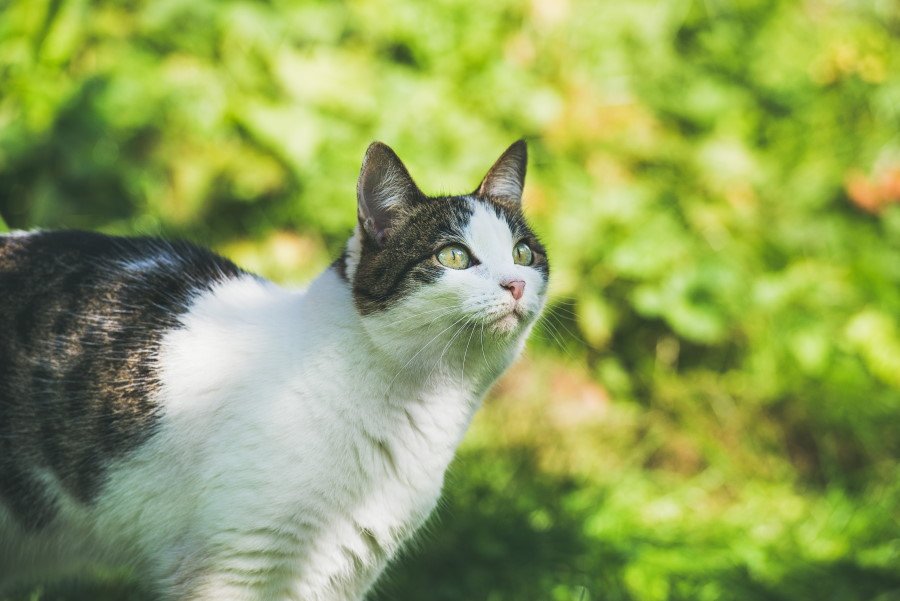When you see your cat looking at you, ears standing up – what does it mean? Reading cat body language is a key skill that every cat parent should know!
There is always a raging battle between cat lovers and dog lovers about which species is more intelligent. Although dogs have more neurons in the cerebral cortex, cats, according to some studies have more in other parts of the brain.
None of these studies have been proven, and opinions on this will always rage on. It does not matter truly about brain size or neurons.
Table of Contents
How To Read Cat Body Language?
Neither cats nor dogs can truly speak so they use body language to communicate. And cats, especially, can have such a variety of body language, and some of it different in each cat, that only trial and error on a cat owner’s part will assist in interpreting what a cat wants.
We all face the dilemma with our cats, of ‘damned if we do, damned if we don’t.’
Cat Rolling Over to Expose Their Stomach
Most cats at some point will lie on their back with their belly exposed. Now, dogs do this routinely for a belly rub. However, in cats, this can simply mean they are relaxed in their environment. It can signal the need for play or attention.
Some DO want a belly rub, but for many cat owners, they find out quickly that this is not the case as their cat can immediately bite or scratch when someone tries to rub their belly.
It does depend on a cat’s personality but being on their backs does simply signal trust first and foremost. With a feral cat, the exposed belly hardly ever occurs, as no matter how long a person can have a feral, they generally do not expose their bellies especially if they were feral for a long time.
That is dangerous to ferals and some cats in general.
So, if you want to rub the belly and hope that is what your cat wants, you can try, but for the most part, it’s a signal of trust and relaxation, and a wise cat owner is usually just happy with that.
Feline Vocalization Combined With Body Language
Cats have a wider vocabulary than dogs or other pets. From purring to meowing to yowling, there is a whole spectrum in between. There can be chirping, hissing, snorting, and even a kind of yodeling which does sound like a yodel!
The most common type of deciphering is purring, you know your cat is happy when they are purring while being petted, or even just lying around.
Now, hard as this might be to believe, some cats, especially ferals, never purr. They just do not do it ever and there is no explanation for it.
It can be a silent purr where although no noise is made if you put your hand under your cat’s throat you will feel a vibration, and that is how a purr is made, through the vibration of the larynx. Hissing, of course, means they are unhappy or threatened in some way.
The hissing may be combined with an arched back and bristling fur as well as a sideways stepping. This is a protective stance that when combined with the hissing will drive danger away (at least in the cats’ minds).
Just think of the Halloween cats you see displayed. That is the protective/danger stance.
Yowling and Grabbing at You as You Pass
Yowling, grabbing at you, or getting right up into your face while doing it (especially when you are in a dead sleep at 4 AM). You know what I’m talking about!
Yowling can occur when cats are hungry, lonely, depressed, bored, or for any other number of reasons. You will find what each instance means as you decipher the reasons little by little. Sick cats usually yowl and can seem lethargic.
But some cats just enjoy talking to themselves and yowl continuously for no other reason than to hear themselves it seems. A yowling cat, though, combined with upturned ears, a fixed stare, and bristling fur, with a head that goes quickly from side-to-side signals danger.
It can even be a fire down the street, as cats can smell danger miles away.
This is what some refer to as the ‘concerned citizen’ look and should never be annoyed.
What Do Cat Tail Movements Mean?
A relaxed happy cat will have an upraised tail as that signals confidence. If they are comfortable in their environment, the upraised tail will not be stiff, however. If the tail is stiff or even curled a bit, the cat can be assessing a situation and not quite sure of its confidence level in a situation.
A tail that is down, or even curled under a cat signals real anxiety and/or illness. You should try and determine why the cat is anxious or if it is ill. A flicking tail is usually seen by owners as a happy cat, but cats are not dogs. They do not wag their tails.
Even if engaged in petting or play, a flicking tail signals overstimulation and you can expect a good swat, a scratch, or even a bite if you continue with the activity. Many cat parents misread the flicking tail the most.
Cats that do not lie on their backs can lie on their sides to show relaxation instead, with the tail and legs spread out. This is also a good sign and at that point, they are as happy as can be.
Rubbing on You or Your Belongings
Cats are territorial. They have glands in their cheeks that emit a scent unique to them. When they rub their heads against you, and your belongings, they are marking their turf. Most cat owners know this so not much explanation will be given here on this.
While they can choose to do this occasionally or all the time depends upon the cat as some are more territorial than others.
If you have a multi-cat household, you can also as a cat parent notice more face rubbing on you and objects than others with only one cat will experience as turf marking increases.
The Slow Blink
Watch your kitty when they’re in a relaxed state and you will notice the slow blink. Cats use this as a way to communicate that they’re happy and relaxed.
I’m going to sound a bit crazy here, but next time you see your cat slow blinking, why not slow blink back at them! Renowned cat expert, Jackson Galaxy explains it in this helpful article.
If you’ve ever wondered if your kitty loves you, the slow blink just might be your answer!
Conclusion:
Each cat and its environment and body language just like humans and other animals will differ. You as a cat parent will spend much time discerning the language of your cat. But that is half the fun, as that is part of the mystical appeal of being owned by a cat!

Jonathon Hyjek is an entrepreneur and cat-lover. He is married to Joy and they share their home with their 2 feline-friends, Franklin & Ollie. Jonathon is a self-admitted “Crazy Cat Guy”. He started this website because of his love for his own cats and their well-being.

